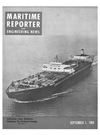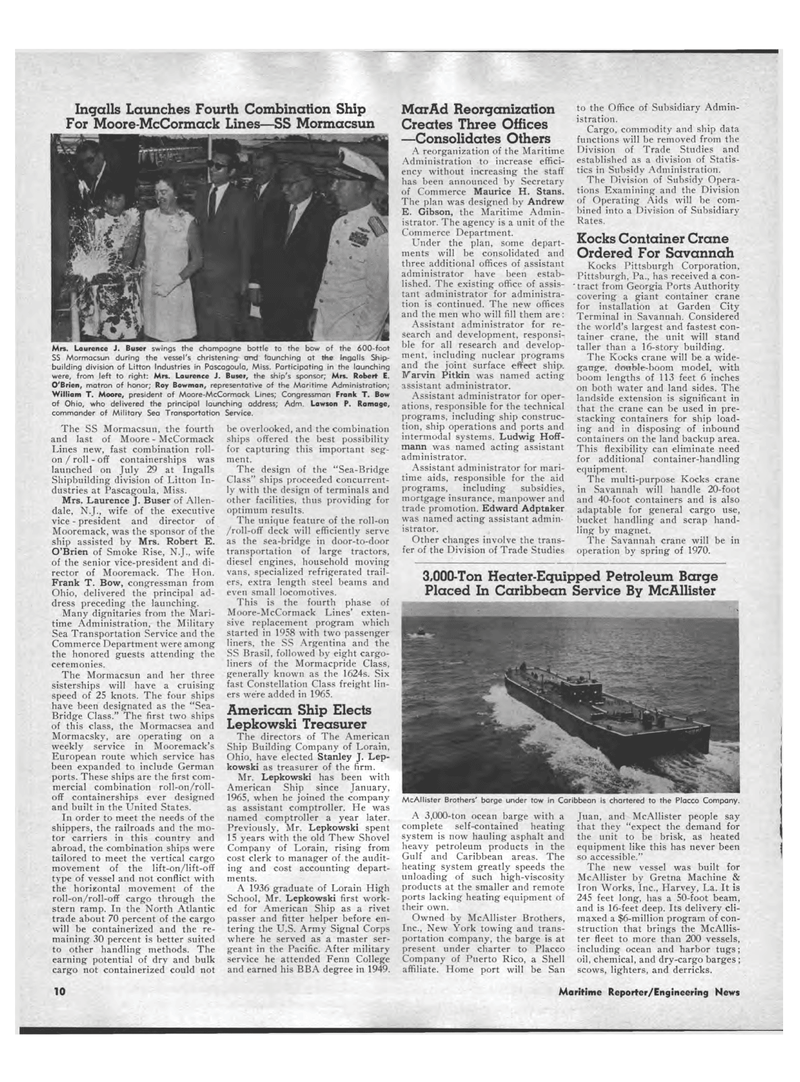
Page 8: of Maritime Reporter Magazine (September 1969)
Read this page in Pdf, Flash or Html5 edition of September 1969 Maritime Reporter Magazine
Ingalls Launches Fourth Combination Ship For Moore-McCormack Lines?SS Mormacsun Mrs. Laurence J. Buser swings the champagne bottle to the bow of the 600-foot SS Mormacsun during the vessel's christening and launching at the Ingalls Ship-building division of Litton Industries in Pascagoula, Miss. Participating in the launching were, from left to right: Mrs. Laurence J. Buser, the ship's sponsor; Mrs. Robert E. O'Brien, matron of honor; Roy Bowman, representative of the Maritime Administration; William T. Moore, president of Moore-McCormack Lines; Congressman Frank T. Bow of Ohio, who delivered the principal launching address; Adm. Lawson P. Ramage, commander of Military Sea Transportation Service. The SS Mormacsun, the fourth and last of Moore - McCormack Lines new, fast combination roll-on / roll - off containerships was launched on July 29 at Ingalls Shipbuilding division of Litton In-dustries at Pascagoula, Miss. Mrs. Laurence J. Buser of Allen-dale, N.J., wife of the executive vice - president and director of Mooremack, was the sponsor of the ship assisted by Mrs. Robert E. O'Brien of Smoke Rise, N.J., wife of the senior vice-president and di-rector of Mooremack. The Hon. Frank T. Bow, congressman from Ohio, delivered the principal ad-dress preceding the launching. Many dignitaries from the Mari-time Administration, the Military Sea Transportation Service and the Commerce Department were among the honored guests attending the ceremonies. The Mormacsun and her three sisterships will have a cruising speed of 25 knots. The four ships have been designated as the "Sea-Bridge Class." The first two ships of this class, the Mormacsea and Mormacsky, are operating on a weekly service in Mooremack's European route which service has been expanded to include German ports. These ships are the first com-mercial combination roll-on/roll-off containerships ever designed and built in the United States. In order to meet the needs of the shippers, the railroads and the mo-tor carriers in this country and abroad, the combination ships were tailored to meet the vertical cargo movement of the lift-on/lift-off type of vessel and not conflict with the horizontal movement of the roll-on/roll-off cargo through the stern ramp. In the North Atlantic trade about 70 percent of the cargo will be containerized and the re-maining 30 percent is better suited to other handling methods. The earning potential of dry and bulk cargo not containerized could not be overlooked, and the combination ships offered the best possibility for capturing this important seg-ment. The design of the "Sea-Bridge Class" ships proceeded concurrent-ly with the design of terminals and other facilities, thus providing for optimum results. The unique feature of the roll-on /roll-off deck will efficiently serve as the sea-bridge in door-to-door transportation of large tractors, diesel engines, household moving vans, specialized refrigerated trail-ers, extra length steel beams and even small locomotives. This is the fourth phase of Moore-McCormack Lines' exten-sive replacement program which started in 1958 with two passenger liners, the SS Argentina and the SS Brasil, followed by eight cargo-liners of the Mormacpride Class, generally known as the 1624s. Six fast Constellation Class freight lin-ers we're added in 1965. American Ship Elects Lepkowski Treasurer The directors of The American Ship Building Company of Lorain, Ohio, have elected Stanley J. Lep-kowski as treasurer of the firm. Mr. Lepkowski has been with American Ship since January, 1965, when he joined the company as assistant comptroller. He was named comptroller a year later. Previously, Mr. Lepkowski spent 15 years with the old Thew Shovel Company of Lorain, rising from cost clerk to manager of the audit-ing and cost accounting depart-ments. A 1936 graduate of Lorain High School, Mr. Lepkowski first work-ed for American Ship as a rivet passer and fitter helper before en-tering the U.S. Army Signal Corps where he served as a master ser-geant in the Pacific. After military service he attended Fenn College and earned his BBA degree in 1949. MarAd Reorganization Creates Three Offices ?Consolidates Others A reorganization of the Maritime Administration to increase effici-ency without increasing the staff has been announced by Secretary of Commerce Maurice H. Stans. The plan was designed by Andrew E. Gibson, the Maritime Admin-istrator. The agency is a unit of the Commerce Department. Under the plan, some depart-ments will be consolidated and three additional offices of assistant administrator have been estab-lished. The existing office of assis-tant administrator for administra-tion is continued. The new offices and the men who will fill them are: Assistant administrator for re-search and development, responsi-ble for all research and develop-ment, including nuclear programs and the joint surface effect ship. Warvin Pitkin was named acting assistant administrator. Assistant administrator for oper-ations, responsible for the technical programs, including ship construc-tion, ship operations and ports and intermodal systems. Ludwig Hoff-mann was named acting assistant administrator. Assistant administrator for mari-time aids, responsible for the aid programs, including subsidies, mortgage insurance, manpower and trade promotion. Edward Adptaker was named acting assistant admin-istrator. Other changes involve the trans-fer of the Division of Trade Studies A 3,000-ton ocean barge with a complete self-contained heating system is now hauling asphalt and heavy petroleum products in the Gulf and Caribbean areas. The heating system greatly speeds the unloading of such high-viscosity products at the smaller and remote ports lacking heating equipment of their own. Owned by McAllister Brothers, Inc., New York towing and trans-portation company, the barge is at present under charter to Placco Company of Puerto Rico, a Shell affiliate. Home port will be San to the Office of Subsidiary Admin-istration. Cargo, commodity and ship data functions will be removed from the Division of Trade Studies and established as a division of Statis-tics in Subsidy Administration. The Division of Subsidy Opera-tions Examining and the Division of Operating Aids will be com-bined into a Division of Subsidiary Rates. Kocks Container Crane Ordered For Savannah Kocks Pittsburgh Corporation, Pittsburgh, Pa., has received a con-' tract from Georgia Ports Authority covering a giant container crane for installation at Garden City Terminal in Savannah. Considered the world's largest and fastest con-tainer crane, the unit will stand taller than a 16-story building. The Kocks crane will be a wide-gauge, dowbie-boom model, with boom lengths of 113 feet 6 inches on both water and land sides. The landside extension is significant in that the crane can be used in pre-stacking containers for ship load-ing and in disposing of inbound containers on the land backup area. This flexibility can eliminate need for additional container-handling equipment. The multi-purpose Kocks crane in Savannah will handle 20-foot and 40-foot containers and is also adaptable for general cargo use, bucket handling and scrap hand-ling by magnet. The Savannah crane will be in operation by spring of 1970. Juan, and McAllister people say that they "expect the demand for the unit to be brisk, as heated equipment like this has never been so accessible." The new vessel was built for McAllister by Gretna Machine & Iron Works, Inc., Harvey, La. It is 245 feet long, has a 50-foot beam, and is 16-feet deep. Its delivery cli-maxed a $6-million program of con-struction that brings the McAllis-ter fleet to more than 200 vessels, including ocean and harbor tugs; oil, chemical, and dry-cargo barges ; scows, lighters, and derricks. 3,000-Ton Heater-Eguipped Petroleum Barge Placed In Caribbean Service By McAllister McAllister Brothers' barge under tow in Caribbean is chartered to the Placco Company. 10 Maritime Reporter/Engineering News

 7
7

 9
9
